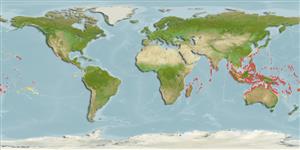>
Blenniiformes (Blennies) >
Blenniidae (Combtooth blennies) > Salariinae
Etymology: Cirripectes: Latin, cirrus = curl fringe + Greek, pektos, -e, -on = made of several parts solidly united (Ref. 45335); polyzona: Specific epithet 'polys' Greek word meaning many and Latin 'zona' meaning belt, referring to the barred color pattern of adults..
More on author: Bleeker.
Environment: milieu / climate zone / depth range / distribution range
Ecologia
marino associati a barriera corallina; distribuzione batimetrica 0 - 20 m (Ref. 529), usually ? - 10 m (Ref. 90102). Tropical; 35°N - 30°S
Indo-Pacific: South Africa to Kiribati, north to Japan (Ref. 559), south to Rowley Shoals and the southern Great Barrier Reef.
Length at first maturity / Size / Peso / Age
Maturity: Lm ?, range 4 - ? cm
Max length : 13.0 cm TL maschio/sesso non determinato; (Ref. 9710)
Spine dorsali (totale): 11 - 13; Raggi dorsali molli (totale): 13-15; Spine anali 2; Raggi anali molli: 14 - 16; Vertebre: 29 - 31. Diagnosis: Dorsal fin XI-XIII (usually XII), 13-15, deeply incised above last spine, first spine almost equal to second; anal fin II, 14-16 (usually 15); pectoral rays 15; pelvic fin I, 3; caudal fin procurrent rays 9-12. Vertebrae 10 + 19-20; last pleural rib on 11th, last epipleural rib on 15-19th vertebral centrum. Without scales and scalelike flaps. LL tubes 2-9 (usually 4-7), series ends below dorsal fin ray 7 or after. Lower lip smooth mesially, plicate laterally. Upper lip crenulae 32-45. Gill rakers 18-25. Cephalic sensory pore system complex; 1 pore behind nuchal flap. Cirri supraorbital 4-15, nasal 5-24; nuchal 32-44. Nuchal cirri in 4 groups with slightly expanded nuchal flap. Head reticulated with pale grey spots. Iris inner ring yellow, outer ring red. Body dark brown with 12 pale grey bars. Juvenile tan above, white to lavender below, with broad dark midlateral stripe, white eye bar, yellow spots on head underside and on operculum. No geographical variation recorded but secondary sexual dichromatism was found (Ref. 529, 90102). Three color pattern variation noted in Ref. 635.
Facultative air-breathing in the genus (Ref. 126274); Occur in algal ridge and ridge crests between surge channels of exposed seaward reefs to a depth of about 3 m (Ref. 205, 58302). Benthic (Ref. 58302). Feed on algae and associated minute invertebrates like forams, ostracods, and gastropods. Oviparous. Eggs are demersal and adhesive (Ref. 205), and are attached to the substrate via a filamentous, adhesive pad or pedestal (Ref. 94114). Larvae are planktonic, often found in shallow, coastal waters (Ref. 94114).
Life cycle and mating behavior
Maturità | Riproduzione | Deposizione | Uova | Fecundity | Larve
Oviparous, distinct pairing (Ref. 205). Urogenital orifice of male genital papilla located basally between 2 widely separated slender filaments on a fleshy swelling behind anus; testes bulbous with length equal its width (Ref. 529).
Williams, J.T., 1988. Revision and phylogenetic relationships of the blenniid fish genus Cirripectes. Indo-Pac. Fish. (17):78 p. (Ref. 529)
IUCN Red List Status (Ref. 130435)
Threat to humans
Harmless
Human uses
Pesca: di nessun interesse
Informazioni ulteriori
BibliografiaAcquacolturaProfilo di acquacolturaVarietàGeneticaElectrophoresesEreditarietàMalattieElaborazioneNutrientsMass conversion
Strumenti
Special reports
Download XML
Fonti Internet
Estimates based on models
Preferred temperature (Ref.
123201): 26.1 - 29.3, mean 28.5 °C (based on 2768 cells).
Phylogenetic diversity index (Ref.
82804): PD
50 = 0.5000 [Uniqueness, from 0.5 = low to 2.0 = high].
Bayesian length-weight: a=0.00741 (0.00335 - 0.01640), b=3.02 (2.83 - 3.21), in cm total length, based on LWR estimates for this (Sub)family-body shape (Ref.
93245).
Trophic level (Ref.
69278): 2.8 ±0.38 se; based on food items.
Resilienza (Ref.
120179): Alto, tempo minimo di raddoppiamento della popolazione meno di 15 mesi (Preliminary K or Fecundity.).
Fishing Vulnerability (Ref.
59153): Low vulnerability (10 of 100).
Nutrients (Ref.
124155): Calcium = 124 [63, 189] mg/100g; Iron = 0.732 [0.442, 1.198] mg/100g; Protein = 18.2 [17.1, 19.3] %; Omega3 = 0.0901 [, ] g/100g; Selenium = 24.4 [12.6, 50.0] μg/100g; VitaminA = 118 [37, 377] μg/100g; Zinc = 1.99 [1.36, 2.76] mg/100g (wet weight);
